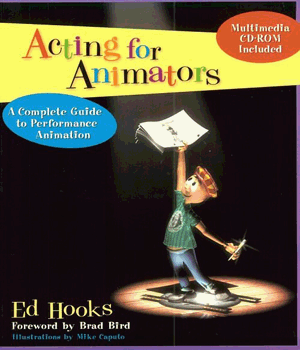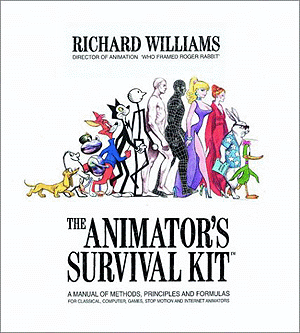
Recommended Reading
Here, after my brief musings about character animation, are some recommended books and videos that you might want to look into.
Character Animation
In my opinion, here are the three main things that an animator
should think about and understand before beginning a
project:
1) The story or situation: both in text and subtext: In other words, what is going on, and what is really going on? The character might be telling another character to leave, but does he really want her to go or is he just being stubborn? If you're working from a script that you didn't write, read the whole thing if at all possible. (Some people don't like reading the whole script because it will ruin the movie for them when they go to see the finished thing. Too bad, read it!)
2) Character: What is the character like? What kind of personality does it have? How does the character fit into the story? What are its goals? What is its point of view? How does it think? Personality, charisma and screen presence are what make any actor, real or animated, successful.
3) The process: How does what you came up with for 1 and 2 weigh on what you need to do? How can you best convey to the audience what you've learned in 1 and 2?
Recommended Reading and
Viewing
First and foremost, check out http://www.joecosman.com and http://www.characterfx.com to see what videos and
DVD's are currently available for messiah. The
training videos that are available there are useful for novices and
professionals alike. Joe Cosman and John Riggs, who run those
companies, are both Hollywood professionals with years of
experience in character setup and animation.
Next, two excellent books have recently been published that every animator should own:

Acting For Animators by Ed Hooks - The name says it all. The most important thing for character animators to understand is that the art of character animation isn't really the art of smooth motion and nicely looping walk cycles, it's the art of acting. What you do with character animation is create a performance, just like any other kind of acting. So this book is great because it's a clear and concise introduction to the world of acting, with an emphasis on the physical side.

The Animator's Survival Kit by Richard Williams - Again, the name says it all. This is a compendium of valuable information and it's not specific to any particular kind of animation (2D or 3D) or any particular software.
More Stuff:
There's a lot out there--far too much to list-- but here are some
ideas to get you started...
Books
about filmmaking:
The Five C's of Cinematography by Joseph V. Mascelli
Painting With Light by John
Alton
Film
Lighting by Kris Makiewicz
Cinematography by Kris Makiewicz
The Bare Bones Camera Course for Film & Video by Tom
Schroeppel
From
Script to Screen by Linda Seger & Edward Jay Whetmore
When the Shooting Stops, The Cutting Begins by Ralph
Rosenbloom
Books about acting:
Acting for the Camera by Tony Barr
Acting in Film by Michael Caine (There's a great video available that's hard to find but highly
recommended.)
Other Books about animation:
Each of these books is a "standard."
The Animation Book by Kit Laybourne
Animation From Script to Screen by Shamus Culhane
The Illusion of Life by Frank Thomas and Ollie Johnston (Out of print but worth finding.)
Miscellaneous books:
Anything at all by Eadweard Muybridge. Muybridge was one of the fathers of motion pictures, but more than that, he laid the groundwork for photographic motion studies-- something he invented single-handedly. His work, from well over a hundred years ago, is still the definitive and most widely used resource.
Movies:
Perhaps the best way to study motion, both real and animated, is to watch movies. Now, of course you've been doing that your whole life, but as an animator there are other things to watch for besides pure entertainment. The movies listed below each have things that can help you understand how important "performance" is. Some of them are silent films, and others have characters that are silent, yet each manage to convey inner thought, plot and personality, all through just motion.Any silent Charlie Chaplin film, especially The Circus (1928), which has a great scene wherein Charlie auditions for the part of a clown. Watch how it's the movement alone that makes him funnier than the clowns themselves. Of course, his sound films are interesting too, in regard to how his acting style translated to sound.
Any Buster Keaton film, especially Sherlock Jr. (1924) Buster was one of the most inventive filmmakers ever, and Sherlock Jr. is one of his masterpieces (one of many actually).
Harry Langdon's The Strong Man. Langdon is not everyone's cup of tea, but he had an acting style based on slow, small motions that is both unique and extremely funny. I recommend watching as much Chaplin and Keaton as you can before giving Harry a try. It's in the way that he was so different that makes a lot of his humor work. (And it was directed by Frank Capra, of "It's A Wonderful Life" fame, so it's interesting in that regard too.)
Mighty Joe Young (1949). This is still the best example of bringing a character to life through animation.
Antz (1998). Absolutely beautiful work from everyone involved. The lead characters each has a distinct acting style. The DVD has lots of extras and is a great value.
Jason and the Argonauts (1963). Ray Harryhausen is the master. Period. Watch the skeleton battle in this film and marvel at how complex it was and that it was all done by one person and one frame at a time, with no OpenGL previews, and no Undo. Watch it and be thankful for the tools now at your disposal.
Looney Tunes. All of the great Warner Brothers cartoons from the Golden Age. Watch these again with an eye towards how and why they're funny. Notice that it's not the violence itself that's funny (something the newer breed hasn't realized). What makes them funny, in my opinion, is the structure and timing of the gags. For example, it's not the fact that an anvil falls on Wile E. Coyote's head, it's the perfect timing of it. One instant earlier and it would have been too soon, spoiling the moment of thought for Wile E. One instant later and it would have been too late, prolonging the moment too much. Or look at the old dynamite gag. There are generally two ways to make it funny: a) The dynamite explodes at the instant he lights the fuse, or b) it waits a long time-- just long enough to give him a believable reason to go investigate, then goes off at the instant he does so. It wouldn't be funny, in my opinion if he lit it, waited a second to make sure it didn't go out, and then it went off.
And of course, the personality of Wile E. himself makes it funny. His absolute blind and stupid belief in himself, his totally unwarranted faith in his plans, and his solid determination are what drive the humor. If his character were always unsure of himself it wouldn't be half as funny.
And of course there are tons of other films worth viewing. I didn't mention the wonderful Pixar films specifically because I'm sure everyone already owns them or has at least seen them.
| Converted from CHM to HTML with chm2web Pro 2.82 (unicode) |